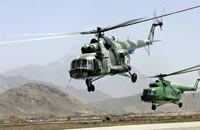US Senate Cracks Down on Pentagon for Purchasing Perfect Mi-17 Choppers from Russia
U.S. lawmakers do not want the Pentagon to buy Mi-17 helicopters from Russia for operations in Afghanistan.

U.S. military has already bought 31 units of Mi-17 and spent 648 million dollars for this deal. Yet, the Pentagon had no intention to stop there and was planning to buy 10 more of these Russian helicopters in the next year.
This caused uproar in the U.S. Senate. In their words, why buy helicopters from Russia while there are American manufacturers lined up for the state orders that are ready to supply their product for Afghan needs for the mere pennies.
American Brigadier General Michael Bauer is the opponent in this dispute with the Senators. He believes that the refusal from the purchase of Russian helicopters will significantly delay the date of creation of army aviation in Afghanistan, which will drag things way up to 2018.
Russia Today: Russia to sell weapons to NATO members
The general believes that the Mi-17 is practically perfect for the conditions in Afghanistan. "We must overcome the fact that we are talking about a Russian helicopter,” he advised the senators. “It works well in Afghanistan."
Considering the Russian Mi-17, the Pentagon has more than just Afghanistan in mind. It has already purchased eight of these helicopters for the armed forces of Iraq, another 14 went to Pakistan.
The U.S. Ministry of Defense does not want to neglect its own armed forces. The Pentagon is seriously considering purchasing Russian vehicles for the Special Operations Command of the U.S. Army. Mi-17 would be ideal for camouflage during operations conducted by U.S. commandos.
The Mil Mi-17 (also known as the Mi-8M series in Russian service, NATO reporting name "Hip") is a Russian-designed helicopter currently in production at two factories in Kazan and Ulan-Ude. Mil Mi-8/17 is a medium twin-turbine transport helicopter that can also act as a gunship. The Soviet Union specifically designed the Mi-17 for the Soviet war in Afghanistan.
Developed from the basic Mi-8 airframe, the Mi-17 was fitted with the larger TV3-117MT engines, rotors, and transmission developed for the Mi-14, along with fuselage improvements for heavier loads. Optional engines for 'hot and high' conditions are the 1545 kW (2070 shp) Isotov TV3-117VM. Recent exports to China and Venezuela for use in high mountains have the new VK-2500 version of the engine with FADEC control.
In October 2007 defense-aerospace.com reported the government of Saudi Arabia had signed a contract for up to 150 Mi-35 and Mi-17 helicopters worth $2.2billion.
In May 2008, licensed production of the Mi-17 started in China with production being led by Mil Moscow Helicopter Plant JSC and the Sichuan Lantian Helicopter Company Limited in Chengdu, Sichuan province. The plant had built 20 helicopters in 2008, using Russian Ulan-Ude-supplied kits. The production is expected to reach 80 helicopters per year eventually. The variants to be built by Lantian will include Mi-171, Mi-17V5, and Mi-17V7.
Komsomolskaya Pravda
Additional information: Wikipedia
Subscribe to Pravda.Ru Telegram channel, Facebook, RSS!




